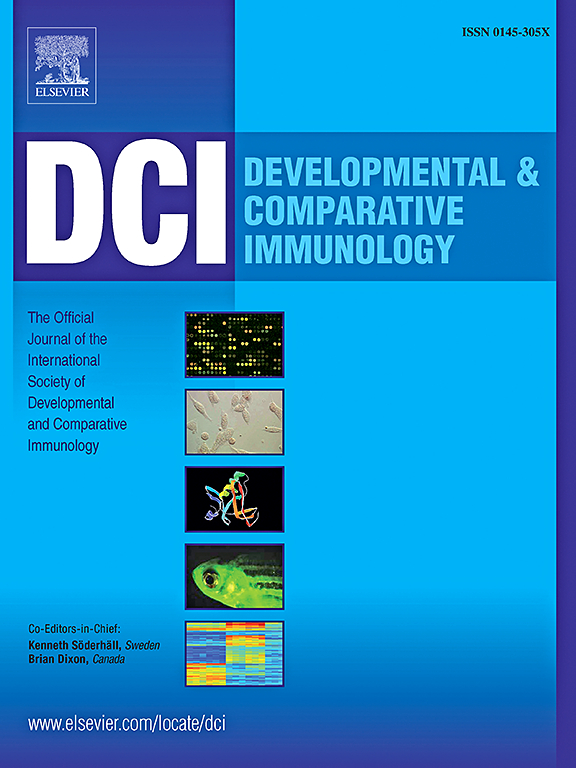用显示源自禽流感病毒和人类甲型流感病毒的 M2e 的嵌合病毒样颗粒免疫鸡产生广泛的交叉反应。
IF 2.7
3区 农林科学
Q1 FISHERIES
引用次数: 0
摘要
尽管已有疫苗,但甲型禽流感病毒(IAV)对全球家禽业构成了持续威胁。此外,反向动物传染可能会将源于人类的 IAV 带入家禽体内,使控制流感传播的工作变得更加复杂。目前的禽流感疫苗主要基于快速变异的血凝素(HA)和神经氨酸酶(NA)糖蛋白,这限制了其对不同 IAV 株系的效力。因此,人们广泛研究了 IAV 的基质 2 蛋白(M2e)的高度保守外结构域,将其作为 HA 和 NA 的替代物。然而,禽类和人类 IAV 的 M2e 氨基酸序列不同,产生的抗体不能与其他来源的 IAV 产生交叉反应。为了扩大 M2e 的免疫原性并提高其免疫原性,我们将来自禽类和人类 IAV 的 M2e 各两个拷贝融合在巨手鱼结节病毒(MrNV)囊膜蛋白(NvC)的 C 端。透射电子显微镜和动态光散射分析表明,嵌合蛋白可自组装成病毒样颗粒(VLPs)。用嵌合 VLPs 对鸡进行免疫,结果表明能诱导出针对禽类和人类 IAV M2e 的广泛反应性免疫应答。此外,嵌合 VLP 还能诱导细胞毒性 T 淋巴细胞 (CTL)、巨噬细胞以及 Th1 和 Th2 群体的均衡产生,这表明它们具有激活鸡体内细胞介导免疫反应的潜力。此外,嵌合 VLPs 还能引发 Th1 和 Th2 细胞因子的产生,这证明它们有潜力在禽类中产生强大而平衡的免疫反应。这项研究证明了这些嵌合 VLPs 在激发和扩大鸡对禽类和人类 IAV 的交叉反应免疫应答方面的潜力。本文章由计算机程序翻译,如有差异,请以英文原文为准。
Broadly cross-reactive immune responses in chickens immunized with chimeric virus-like particles of nodavirus displaying the M2e originated from avian and human influenza A viruses
Avian influenza A viruses (IAVs) pose a persistent threat to poultry industry worldwide, despite the presence of vaccines. Additionally, reverse-zoonosis transmission potentially introduces human-originated IAVs into poultry and complicates the efforts to control the spread of influenza. Current avian influenza vaccines are primarily based upon the rapidly mutating hemagglutinin (HA) and neuraminidase (NA) glycoproteins, which limit their efficacy against diverse strains of IAVs. Hence, the highly conserved ectodomains of matrix 2 protein (M2e) of IAVs are widely studied as alternatives to the HA and NA. However, the differences in the M2e amino acid sequences between avian and human IAVs generate antibodies that do not cross-react reciprocally with IAVs from other origins. To broaden and enhance the immunogenicity of M2e, we fused two copies each of the M2e derived from avian and human IAVs at the C-terminal end of the Macrobrachium rosenbergii nodavirus (MrNV) capsid protein (NvC). Transmission electron microscopic and dynamic light scattering analyses revealed that the chimeric protein self-assembled into virus-like particles (VLPs). Immunization of chickens with the chimeric VLPs demonstrated a robust induction of broadly reactive immune responses against both the M2e of avian and human IAVs. Additionally, the chimeric VLPs elicited the production of cytotoxic T lymphocytes (CTL), macrophages, as well as a well-balanced Th1 and Th2 population, indicating their potential in activating cell-mediated immune responses in chickens. Furthermore, the chimeric VLPs triggered the production of both Th1- and Th2-cytokines, attesting their potential in mounting a robust and balanced immune response in avian species. This study demonstrated the potential of these chimeric VLPs in stimulating and broadening cross-reactive immune responses in chickens against both avian and human IAVs.
求助全文
通过发布文献求助,成功后即可免费获取论文全文。
去求助
来源期刊
CiteScore
6.20
自引率
6.90%
发文量
206
审稿时长
49 days
期刊介绍:
Developmental and Comparative Immunology (DCI) is an international journal that publishes articles describing original research in all areas of immunology, including comparative aspects of immunity and the evolution and development of the immune system. Manuscripts describing studies of immune systems in both vertebrates and invertebrates are welcome. All levels of immunological investigations are appropriate: organismal, cellular, biochemical and molecular genetics, extending to such fields as aging of the immune system, interaction between the immune and neuroendocrine system and intestinal immunity.

 求助内容:
求助内容: 应助结果提醒方式:
应助结果提醒方式:


